|
|
|
Sort Order |
|
|
|
Items / Page
|
|
|
|
|
|
|
| Srl | Item |
| 1 |
ID:
144333
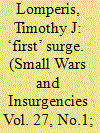

|
|
|
|
|
| Summary/Abstract |
In a military intervention, do surges work? I compare the failed ‘surge’ in Vietnam, the repulse of the Easter Invasion in 1972, as a means of assessing the more ambiguous surges in Iraq and Afghanistan. I identify four features of a surge for this analysis: the military dimensions and strategy of the surging forces, the military capabilities of the host forces, the political vitality and will of the host country, and the political commitment in the domestic politics of the intervener. I find that the last feature is the most critical; and, in all three surges, the American political commitment was lacking.
|
|
|
|
|
|
|
|
|
|
|
|
|
|
|
|
| 2 |
ID:
173835
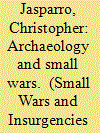

|
|
|
|
|
| Summary/Abstract |
The protection, destruction, utilization and manipulation of cultural property and material heritage, especially archaeological sites and artifacts, by state and non-state actors has become commonplace in contemporary small wars and hybrid conflicts. The U.S. and its western allies have taken a limited and largely legalistic and limited approach to this development in contemporary warfare to the advantage of adversaries who have made control of the past a key part of their strategies and operations. This paper traces the role of cultural heritage in small warfare from ancient times through its contemporary re-emergence and what the implications are for future small wars.
|
|
|
|
|
|
|
|
|
|
|
|
|
|
|
|
| 3 |
ID:
125187
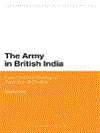

|
|
|
|
|
| Publication |
London, Bloomsbury, 2013.
|
| Description |
xi, 238p.Hbk
|
| Contents |
B
|
| Standard Number |
9781441177308
|
|
|
|
|
|
|
|
|
|
|
|
Copies: C:1/I:0,R:0,Q:0
Circulation
| Accession# | Call# | Current Location | Status | Policy | Location |
| 057525 | 954.03/ROY 057525 | Main | On Shelf | General | |
|
|
|
|
| 4 |
ID:
053072
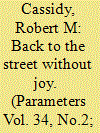

|
|
|
| 5 |
ID:
068644
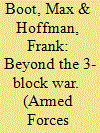

|
|
|
| 6 |
ID:
114677
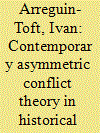

|
|
|
|
|
| Publication |
2012.
|
| Summary/Abstract |
This article offers an intellectual history of theoretical work devoted to explaining asymmetric conflict outcomes since World War II. Three factors are critical to understanding how the literature has evolved. First, the concept of "asymmetric conflict" encompasses a number of overlapping literatures, including insurgency, terrorism, counterinsurgency, and most recently, civil wars. Second, and interrelated, the field of inquiry has been unproductively divided between military and academic thinkers, with insufficient engagement between the two communities. Third, the popularity of the field of inquiry following the events of September 11, 2001, and the subsequent American-led military operations in Afghanistan (2001) and Iraq (2003) have resulted in analyses that are empirically rich, but have provided little in the way of theoretical advances. The conclusion offers an overall assessment of the field of inquiry into asymmetric conflict outcomes, suggested directions for future research, and a table of major contributors to the literature, their key questions, case universes, intended contributions, and theoretical limitations.
|
|
|
|
|
|
|
|
|
|
|
|
|
|
|
|
| 7 |
ID:
105995


|
|
|
|
|
| Publication |
2011.
|
| Summary/Abstract |
Counterinsurgency (COIN) has again emerged as a topic of both contemporary and historical interest in the age of what has been called a global counterinsurgency. However, little attention is being paid to the historical lineage of a COIN doctrine that is being rediscovered and promoted by an enthusiastic group of military intellectuals and commanders as the basis for US Army and Marine Corps doctrine. This article argues that historical claims for COIN success, based on courting popular gratitude by improving economic conditions, are at best anchored in selective historical memory, when not fantasy fabrications. The first argument of this article is that COIN does not constitute a distinct form of warfare, but merely a sub-set of minor tactics. Second, 'hearts and minds', so-called population-centric warfare, has seldom been a recipe for lasting stability. Rather, historically counterinsurgency succeeded when it has shattered and divided societies by severely disrupting civilian life. In fact, COIN is a nineteenth century legacy of empire whose uniqueness and impact was mythologized in its own day, and that is unlikely to prove a formula for strategic success in the twenty-first century.
|
|
|
|
|
|
|
|
|
|
|
|
|
|
|
|
| 8 |
ID:
114604
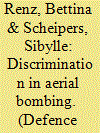

|
|
|
|
|
| Publication |
2012.
|
| Summary/Abstract |
This article questions the notion that the norm of discrimination in air
warfare has become increasingly relevant among Western publics, policy-makers and the military in the course of the 20th century. The article offers a critique of the existing literature, which tends to
overemphasise the contrast between the largely indiscriminate use of air
power in World War II on the one hand and the greater restraint in air
strikes in armed con?icts in the second half of the 20th century on the
other. This critique will be underpinned by six short case studies discussing the uses of air power in limited con?icts from the 1920s to-today. The ?ndings indicate that the norm of discrimination had a great
salience in small wars ever since the emergence of air power
|
|
|
|
|
|
|
|
|
|
|
|
|
|
|
|
| 9 |
ID:
158976
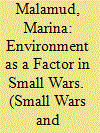

|
|
|
|
|
| Summary/Abstract |
This research paper analyzes the relationship between small wars, insurgency, and the natural environment. Existing literature and data are organized into four behavioral patterns: the resource-based wars accounts for the fight over natural resources; the warfare ecology paradigm refers to non-premeditated damage in preparation for as well as during and after conflicts; the environment as a target discusses intended attacks on the ecosystem; and the insurgency–climate intersection pattern denotes a deviation in climate change that increases the frequency of intergroup violence. The main premise is that small wars emerge when the ecosystem becomes a political asset.
|
|
|
|
|
|
|
|
|
|
|
|
|
|
|
|
| 10 |
ID:
021560
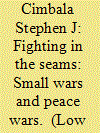

|
|
|
|
|
| Publication |
Spring 2000.
|
| Description |
1-18
|
|
|
|
|
|
|
|
|
|
|
|
|
|
|
|
| 11 |
ID:
167192
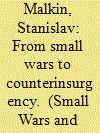

|
|
|
|
|
| Summary/Abstract |
The complicated problematic of Imperial Policing in many respects still comes down to the principle of minimum force, and much of what we consider an integral part of the modern doctrine of counterinsurgency, is perceived as by-product of post-1945 colonial experience. Charles Gwynn wrote about it in his still underestimated text-book on internal security, ‘Imperial Policing’. As a result, there is a lack of clear understanding how colonial (based on local experience) knowledge was transformed into the expert (universal, transferable) knowledge in confronting rebellions at the doctrinal level. This article examines the work of Gwynn as part of a transitional stage from the age of global empires to the age of nuclear superpowers within the context of internal security doctrine. Adaptation to the new realities during the interwar period and after the World War II – reconfiguration of the British army epistemological system in confronting insurgencies – was a hard process. In this sense, the question about transformation of colonial knowledge into expert knowledge onto the field of internal security is a part of a more general and sensitive question about transition from colonialism to the post-colonial age.
|
|
|
|
|
|
|
|
|
|
|
|
|
|
|
|
| 12 |
ID:
133516
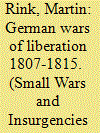

|
|
|
|
|
| Publication |
2014.
|
| Summary/Abstract |
In the Age of Napoleon, 'small wars' and 'revolutionary war' were closely connected. There were, however, different strands of this phenomenon: speaking professionally, conservative officers condemned small wars as an irregular regression to previous less disciplined forms of warfare. The Prussian state continually tried to discipline and regulate spontaneous risings. Yet the irregular character of small wars offered the opportunities for a less complex way of fighting, thus enabling the arming of the 'people' to fight. Individual undertakings, such as Ferdinand von Schill's doomed campaign in 1809, were designed to spark off a general popular uprising. But they were cheered by many and supported by few. Meanwhile, Neidhardt von Gneisenau conceived guerrilla-style Landsturm home-defence forces, which were designed for an irregular people's war. These concepts were put into practice in the 'war of freedom' - or 'war of liberation' - in 1813. Eventually both the mobilisation and the tactics remained regular, however, despite the emphatic appeal to a national 'people's war'.
|
|
|
|
|
|
|
|
|
|
|
|
|
|
|
|
| 13 |
ID:
046526
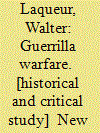

|
|
|
|
|
| Publication |
New Brunswick, Transaction Publishers, 2002.
|
| Description |
xx, 462p.
|
| Standard Number |
0887386563
|
|
|
|
|
|
|
|
|
|
|
|
Copies: C:1/I:0,R:0,Q:0
Circulation
| Accession# | Call# | Current Location | Status | Policy | Location |
| 045110 | 355.0218/LAQ 045110 | Main | On Shelf | General | |
|
|
|
|
| 14 |
ID:
133634
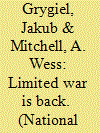

|
|
|
|
|
| Publication |
2014.
|
| Summary/Abstract |
EUROPE NEEDS to rearm and defend itself to cope with a new military threat. The American security umbrella-in both its conventional and nuclear forms-is no longer adequate, particularly on NATO's vulnerable eastern flanks. Indeed, the extended deterrent provided by the United States to its most exposed allies may not be well suited to inhibiting attacks similar to Russia's recent incursion into Ukraine, which displayed all the hallmarks of the newly popular limited conventional wars-brief and decisive, violent and yet very restrained. The purpose of such conflicts is to achieve a quick fait accompli in a geographically circumscribed area through limited force-in this case, paramilitary means followed by Russian regular forces. It is difficult to deter such a threat through the promise of retaliation, which by its very nature must occur after the facts on the ground have already been changed. A threat of retaliation is simply less credible when the enemy has achieved his objective through a low-intensity action. What are needed instead are strong local military capabilities-a preclusive defense-that increase the costs of that limited attack. Europe must start to defend its border rather than indulge in the belief that the traditional formula for deterrence, based on retaliation and the extended deterrent provided by the United States, will suffice. It won't.
|
|
|
|
|
|
|
|
|
|
|
|
|
|
|
|
| 15 |
ID:
051441
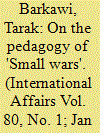

|
|
|
| 16 |
ID:
185070
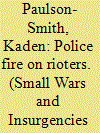

|
|
|
|
|
| Summary/Abstract |
Many have shown how ‘the British way’, a doctrine of minimum force, was problematic in theory and practice, especially in the final decades of empire. While the role of the colonial police in suppressing uprisings is often overlooked, this article argues that the police carried out everyday counterinsurgency campaigns. Using British archival records, this article examines a 1950 dockworker strike in Dar es Salaam, the colonial capital of former Tanganyika. Workers’ resistance was perceived by colonial authorities as insurgency, which led to the crosspollination of new policing strategies throughout the British Empire to expand surveillance, control riots, and break strikes.
|
|
|
|
|
|
|
|
|
|
|
|
|
|
|
|
| 17 |
ID:
091370
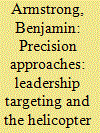

|
|
|
| 18 |
ID:
082138
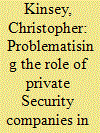

|
|
|
|
|
| Publication |
2007.
|
| Summary/Abstract |
This article sets out to investigate the impact of Private Security Companies (PSCs)1 on civil wars. In doing so, it has taken an historical line, outlining the way the industry has developed from when it first emerged on the international stage in the late 1960s, to the present. Importantly, the article is able to identify three broad strands of involvement in civil wars that include substituting for state military forces, propping up weak governments, and supplementing state militaries. Moreover, in each of these situations, the involvement of PSCs raises both moral and legal questions, as well as challenges for government. This is especially so in light of their activities in Iraq and Afghanistan and the likelihood that governments will increasingly turn to them for niche capabilities.
|
|
|
|
|
|
|
|
|
|
|
|
|
|
|
|
| 19 |
ID:
116251
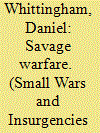

|
|
|
|
|
| Publication |
2012.
|
| Summary/Abstract |
In his classic book Small Wars: Their Principles and Practice (1896), the military theorist Charles E. Callwell divided small wars into three broad classes: wars of conquest were fought to expand empires; pacification campaigns were internal, and often followed campaigns of conquest; campaigns to wipe out an insult, avenge a wrong, or overthrow a dangerous enemy, often developed into wars of conquest. While all three categories involved major political considerations, Callwell's text is often criticised for its lack of discussion of politics. However, Callwell recognised that, if the ultimate objective of a campaign was successfully to assimilate a people into the British Empire, then 'military intimidation' was ill adapted to that end. This article will argue that a strategy of 'butcher and bolt' was indeed considered by many commentators, including Callwell, to be the best way to win 'hearts and minds'. This stemmed from a belief in the all-importance of 'moral effect', a recurring theme in small wars literature. However, to view the British approach to colonial small wars as pure and simple brutality, in a 'dark age' before a more enlightened period of 'minimum force', is an oversimplification.
|
|
|
|
|
|
|
|
|
|
|
|
|
|
|
|
| 20 |
ID:
000479
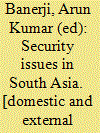

|
|
|
|
|
| Publication |
Calcutta, Minerva Associates, 1998.
|
| Description |
xx, 201p.
|
| Standard Number |
8185195803
|
|
|
|
|
|
|
|
|
|
|
|
Copies: C:1/I:0,R:0,Q:0
Circulation
| Accession# | Call# | Current Location | Status | Policy | Location |
| 041838 | 355.033054/BAN 041838 | Main | On Shelf | General | |
|
|
|
|
|
|
|
|
|